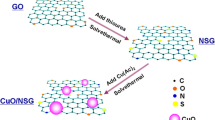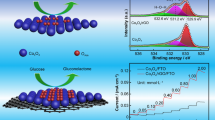Abstract
The development of novel catalyst with high catalytic activity is important for electrochemical non-enzymatic glucose sensing. Here, iridium single-atom/nickel oxide nanoparticle/N-doped graphene nanosheet (Ir1/NiO/NG) with the loading of 1.13 wt% Ir was successfully synthesized for constructing electrochemical non-enzymatic glucose sensor for the first time. The morphology and structure of Ir1/NiO/NG were characterized by XRD, SEM, TEM, HRTEM, and XPS, and the presence of Ir SAs was confirmed by AC-HAADF-STEM. The Ir1/NiO/NG shows 65 mV lower oxidation potential and 3.3 times higher response current than Ni(OH)2/NG. In addition, Ir1/NiO/NG exhibits high sensitivity (70.09 μA mM−1 cm−2), excellent selectivity, low detection limit (2.00 μM), and great stability (91.53% current remaining after 21 days) for electrochemical non-enzymatic glucose sensing. The outstanding catalytic and sensing performance of Ir1/NiO/NG is mainly attributed to synergistic effect of Ir SAs, NiO nanoparticles, and highly conductive NG, which modulate the electronic and geometric structure of Ir1/NiO/NG. This work shows the promising potential of SACs in electrochemical sensing.




Similar content being viewed by others
References
Jiang S, Chen Q, Lin J, Liao G, Shi T, Qian L. Thermal stress-induced fabrication of carbon micro/nanostructures and the application in high-performance enzyme-free glucose sensors. Sens Actuat B: Chem. 2021;345:130364. https://doi.org/10.1016/j.snb.2021.130364.
Liu F, Wang P, Zhang Q, Wang Z, Liu Y, Zheng Z, et al. Porous Co3O4 nanosheets as a high-performance non-enzymatic sensor for glucose detection. Anal Bioanal Chem. 2018;410(29):7663–70. https://doi.org/10.1007/s00216-018-1380-4.
Xia M, Chu S, Wang S, Dong X, Chen C, Jiang Y, et al. Platinum nanoparticles confined in metal–organic frameworks as excellent peroxidase-like nanozymes for detection of uric acid. Anal Bioanal Chem. 2023;415(4):649–58. https://doi.org/10.1007/s00216-022-04453-1.
Zhao Z, Wang T, Li K, Long D, Zhao J, Zhu F, et al. A flexible nonenzymatic sweat glucose sensor based on Au nanoflowers coated carbon cloth. Sens Actuat B: Chem. 2023;388:133798. https://doi.org/10.1016/j.snb.2023.133798.
Chen X, Pan H, Liu H, Du M. Nonenzymatic glucose sensor based on flower-shaped Au@Pd core–shell nanoparticles–ionic liquids composite film modified glassy carbon electrodes. Electrochim Acta. 2010;56(2):636–43. https://doi.org/10.1016/j.electacta.2010.10.001.
Guo MQ, Hong HS, Tang XN, Fang HD, Xu XH. Ultrasonic electrodeposition of platinum nanoflowers and their application in nonenzymatic glucose sensors. Electrochim Acta. 2012;63:1–8. https://doi.org/10.1016/j.electacta.2011.11.114.
Arthanari S, Sivaprakasam R, Park J-E, Yang M, Lee H, Kim B-S, et al. Fabrication of porous non-enzymatic glucose sensing electrodes through nanosecond-laser patterning of met-al–organic frameworks. Adv. Mater. Technol. 2024, 2301561. https://doi.org/10.1002/admt.202301561.
Chen C, Li J, Tang Z, Liao G, Nie L. In-situ co-precipitation of Bi-MOF derivatives for highly sensitive electrochemical glucose sensing. Microchem J. 2024;199:109897. https://doi.org/10.1016/j.microc.2024.109897.
Fan Q, Li X, Dong H, Ni Z, Hu T. ZIF-67 anchored on MoS2/rGO heterostructure for non-enzymatic and visible-light-sensitive photoelectrochemical. Biosensing. 2024;14(1):38. https://doi.org/10.3390/bios14010038.
Jiao L, Yan H, Wu Y, Gu W, Zhu C, Du D, et al. When nanozymes meet single-atom catalysis. Angew Chem Int Ed. 2020;59(7):2565–76. https://doi.org/10.1002/anie.201905645.
Wang A, Li J, Zhang T. Heterogeneous single-atom catalysis. Nat Rev Chem. 2018;2(6):65–81. https://doi.org/10.1038/s41570-018-0010-1.
Jiao L, Xu W, Wu Y, Yan H, Gu W, Du D, et al. Single-atom catalysts boost signal amplification for biosensing. Chem Soc Rev. 2021;50(2):750–65. https://doi.org/10.1039/D0CS00367K.
Mao J, Yin J, Pei J, Wang D, Li Y. Single atom alloy: an emerging atomic site material for catalytic applications. Nano Today. 2020;34:100917. https://doi.org/10.1016/j.nantod.2020.100917.
Zhang L, Ren Y, Liu W, Wang A, Zhang T. Single-atom catalyst: a rising star for green synthesis of fine chemicals. Natl Sci Rev. 2018;5(5):653–72. https://doi.org/10.1093/nsr/nwy077.
Oh J-M, Venters CC, Di C, Pinto AM, Wan L, Younis I, et al. U1 snRNP regulates cancer cell migration and invasion in vitro. Nat Commun. 2020;11(1):1. https://doi.org/10.1038/s41467-019-13993-7.
Huang L, Chen J, Gan L, Wang J, Dong S. Single-atom nanozymes. Sci Adv. 5(5):eaav5490. https://doi.org/10.1126/sciadv.aav5490.
Hou H, Mao J, Han Y, Wu F, Zhang M, Wang D, et al. Single-atom electrocatalysis: a new approach to in vivo electrochemical biosensing. Sci China Chem. 2019;62(12):1720–4. https://doi.org/10.1007/s11426-019-9605-0.
Lei Y, Butler D, Lucking MC, Zhang F, Xia T, Fujisawa K, et al. Single-atom doping of MoS2 with manganese enables ultrasensitive detection of dopamine: experimental and computational approach. Sci Adv. 2020;6(32):eabc4250. https://doi.org/10.1126/sciadv.abc4250.
Xie X, Wang DP, Guo C, Liu Y, Rao Q, Lou F, et al. Single-atom ruthenium biomimetic enzyme for simultaneous electrochemical detection of dopamine and uric acid. Anal Chem. 2021;93(11):4916–23. https://doi.org/10.1021/acs.analchem.0c05191.
Long B, Zhao Y, Cao P, Wei W, Mo Y, Liu J, et al. Single-atom Pt boosting electrochemical nonenzymatic glucose sensing on Ni(OH)2/N-doped graphene. Anal Chem. 2022;94(4):1919–24. https://doi.org/10.1021/acs.analchem.1c04912.
Lin Z, Waller G, Liu Y, Liu M, Wong C-P. Facile synthesis of nitrogen-doped graphene via pyrolysis of graphene oxide and urea, and its electrocatalytic activity toward the oxygen-reduction reaction. Adv Energy Mater. 2012;2(7):884–8. https://doi.org/10.1002/aenm.201200038.
Zou Y, Wang Y. NiO nanosheets grown on graphene nanosheets as superior anode materials for Li-ion batteries. Nanoscale. 2011;3(6):2615–20. https://doi.org/10.1039/C1NR10070J.
Ouyang W, Zeng D, Yu X, Xie F, Zhang W, Chen J, et al. Exploring the active sites of nitrogen-doped graphene as catalysts for the oxygen reduction reaction. Int J Hydrogen Energy. 2014;39(28):15996–6005. https://doi.org/10.1016/j.ijhydene.2014.01.045.
Shukla AK, Kannan AM, Hegde MS, Gopalakrishnan J. Effect of counter cations on electrocatalytic activity of oxide pyrochlores towards oxygen reduction/evolution in alkaline medium: an electrochemical and spectroscopic study. J Power Sources. 1991;35(2):163–73. https://doi.org/10.1016/0378-7753(91)80033-T.
Lu P, Yu J, Lei Y, Lu S, Wang C, Liu D, et al. Synthesis and characterization of nickel oxide hollow spheres–reduced graphene oxide–nafion composite and its biosensing for glucose. Sens Actuat B: Chem. 2015;208:90–8. https://doi.org/10.1016/j.snb.2014.10.140.
Kunitski M, Eicke N, Huber P, Köhler J, Zeller S, Voigtsberger J, et al. Double-slit photoelectron interference in strong-field ionization of the neon dimer. Nat Commun. 2019;10(1):1. https://doi.org/10.1038/s41467-018-07882-8.
Zhu J, Yin H, Cui Z, Qin D, Gong J, Nie Q. Amorphous Ni(OH)2/CQDs microspheres for highly sensitive non-enzymatic glucose detection prepared via CQDs induced aggregation process. Appl Surf Sci. 2017;420:323–30. https://doi.org/10.1016/j.apsusc.2017.05.129.
Cui M-L, Chen Y-S, Xie Q-F, Yang D-P, Han M-Y. Synthesis, properties and applications of noble metal iridium nanomaterials. Coord Chem Rev. 2019;387:450–62. https://doi.org/10.1016/j.ccr.2018.12.008.
Wang Q, Hong G, Liu Y, Hao J, Liu S. Dual enzyme-like activity of iridium nanoparticles and their applications for the detection of glucose and glutathione. RSC Adv. 2020;10(42):25209–13. https://doi.org/10.1039/D0RA05342B.
Ci S, Huang T, Wen Z, Cui S, Mao S, Steeber DA, et al. Nickel oxide hollow microsphere for non-enzyme glucose detection. Biosens Bioelectron. 2014;54:251–7. https://doi.org/10.1016/j.bios.2013.11.006.
Funding
Changsheng Shan acknowledges the National Natural Science Foundation of China (grant Nos. 22274036 and 21874031) and “Chu-Tian Scholar” Program of Hubei Province. Yuanmeng Zhao thanks the National Natural Science Foundation of China (grant No. 22302059).
Author information
Authors and Affiliations
Contributions
Yaojiang Zhou: methodology, conceptualization, investigation, formal analysis, investigation, and writing, original draft. Wen Wei: methodology and investigation. Wenli Lei: methodology and investigation. Fudong Li: methodology and investigation. Jiaxi Shu: methodology and investigation. Zixuan Deng: methodology and investigation. Wenyu Hui: methodology and investigation. Yuanmeng Zhao: resources, discussion, and writing, review and editing. Changsheng Shan: methodology, conceptualization, resources, supervision, and writing, review and editing.
Corresponding author
Ethics declarations
Competing interests
The authors declare no competing interests.
Additional information
Publisher's Note
Springer Nature remains neutral with regard to jurisdictional claims in published maps and institutional affiliations.
Published in the topical collection featuring Nanozymes with guest editors Vipul Bansal, Sudipta Seal, and Hui Wei.
Supplementary Information
Below is the link to the electronic supplementary material.
Rights and permissions
Springer Nature or its licensor (e.g. a society or other partner) holds exclusive rights to this article under a publishing agreement with the author(s) or other rightsholder(s); author self-archiving of the accepted manuscript version of this article is solely governed by the terms of such publishing agreement and applicable law.
About this article
Cite this article
Zhou, Y., Wei, W., Lei, W. et al. Synergistically enhancing electrocatalysis and non-enzymatic sensing for glucose by iridium single-atom/nickel oxide/N-doped graphene. Anal Bioanal Chem (2024). https://doi.org/10.1007/s00216-024-05226-8
Received:
Revised:
Accepted:
Published:
DOI: https://doi.org/10.1007/s00216-024-05226-8




